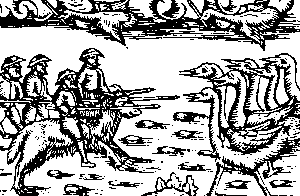Olaus Magnus facts for kids
Quick facts for kids The Most Reverend Olaus Magnus |
|
|---|---|
| Archbishop of Uppsala Primate of Sweden |
|
| Church | Roman Catholic |
| Archdiocese | Uppsala |
| Appointed | 4 June 1544 |
| Reign ended | 1 August 1557 |
| Predecessor | Johannes Magnus |
| Successor | Laurentius Petri |
| Personal details | |
| Birth name | Olof Månsson |
| Born | October 1490 Skänninge, Sweden |
| Died | 1 August 1557 (aged 66) Rome, Papal States |
| Buried | Santa Maria dell'Anima, Rome |
| Nationality | Swede |
Olaus Magnus (born Olof Månsson; October 1490 – 1 August 1557) was a Swedish writer, cartographer (mapmaker), and a Catholic church leader. He is famous for his detailed writings and maps about Northern Europe.
Contents
Olaus Magnus's Life Story
Olaus Magnus was born in Linköping, Sweden, in October 1490. His birth name was Olof Månsson. Like his older brother, Johannes Magnus, Olaus held several important church positions. These included roles in Uppsala and Linköping, and as an archdeacon in Strängnäs.
Early Career and Diplomatic Missions
Olaus worked as a diplomat for the Swedish king, Gustav I of Sweden. In 1524, he went to Rome to help his brother Johannes become the Archbishop of Uppsala. Olaus stayed abroad, handling foreign affairs. He even sent home a document about trade agreements with the Netherlands.
Exile and Life in Rome
During this time, a big change happened in Sweden called the Protestant Reformation. Sweden changed its official religion. Because Olaus was very loyal to the Catholic church, he decided to stay abroad for good. He joined his brother in Poland. Both brothers were forced to leave Sweden, and Olaus's belongings in Sweden were taken by the government in 1530.
In 1537, Olaus settled in Rome and worked as his brother's secretary. When his brother Johannes died in 1544, Pope Paul III named Olaus as the next Archbishop of Uppsala. However, this was just a title, as Sweden was no longer Catholic and Olaus was banned from his home country.
Later Years and Death
In 1545, Pope Paul III sent Olaus to the Council of Trent. This was an important meeting of church leaders. Olaus attended these meetings until 1549. Later, he became a church official at St. Lambert's Cathedral in Liège. The King of Poland, Sigismund I, also offered him a church position in Poznań. Olaus spent the rest of his life at a monastery in Rome, living on money given to him by the Pope. He passed away on August 1, 1557, when he was about 67 years old.
What's in a Name?
Olaus Magnus's original Swedish name was Olof Månsson. "Månsson" means "son of Måns." "Magnus" is a Latin version of his last name. It doesn't mean "great" in this case, but it sounds like the Latin word for "great."
Olaus Magnus's Famous Works
Olaus Magnus is best known for two important works: a book and a map.
Historia de Gentibus Septentrionalibus
His most famous book is called Historia de Gentibus Septentrionalibus. This Latin title means A Description of the Northern Peoples. It was printed in Rome in 1555. This book was a proud work about Swedish traditions and history. For a long time, it was the main source of information about Sweden for the rest of Europe.
The book described dark winters, strong ocean currents, and even sea monsters! It amazed people across Europe. It was translated into many languages, including Italian (1565), German (1567), English (1658), and Dutch (1665). It wasn't translated into Swedish until 1909. Even today, it's a valuable collection of interesting facts about Scandinavian customs and folklore.
What the Book is About
The full Latin title page of the book translates to: "Olaus Magnus Gothus', the Upsala Archbishops', history of the Nordic people's different manners and camps, also about the wonderful differences in customs, holy practices, superstitions, bodily exercises, government and food keeping; further on war, buildings and wonderful aids; further on metals and different kinds of animals, that live in these neighbourhoods (...)".
Carta Marina
Before his big book, Olaus had already created a famous map called Carta marina et Descriptio septemtrionalium terrarum ac mirabilium rerum in eis contentarum, diligentissime elaborata Anno Domini 1539 Veneciis liberalitate Reverendissimi Domini Ieronimi Quirini.
This long Latin title means "A Marine map and Description of the Northern Lands and of their Marvels, most carefully drawn up at Venice in the year 1539 through the generous assistance of the Most Honourable Lord and Patriarch Hieronymo Quirino."
The map also came with a small book that explained it. This book's Italian title translates to: "A little book, that more closely explains a map of the Nordic cold, beyond the Germanic sea located country, which presents its extremely peculiar, priorly known neither to Greeks or Latins, wonders of nature."
The Map's Importance
The carta marina map showed Northern Europe, including Scandinavia. It was rediscovered in 1886 and was found to be the most accurate map of its time. The map is very large, measuring 125 cm tall and 170 cm wide, and is made up of 9 parts.
After his brother's death, Olaus also helped publish historical writings that his brother had created.
Today, scientists who study the ocean have found that Olaus Magnus was very good at observing details. Even though his maps included imaginary things like sea monsters, he accurately showed ocean currents between Iceland and the Faroe Islands.
See also
 In Spanish: Olaus Magnus para niños
In Spanish: Olaus Magnus para niños



